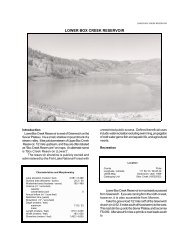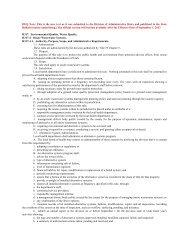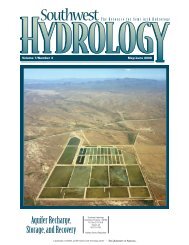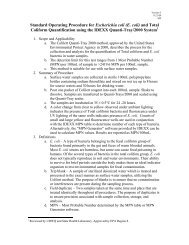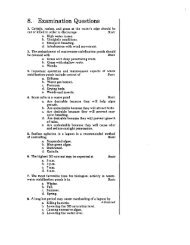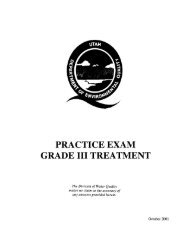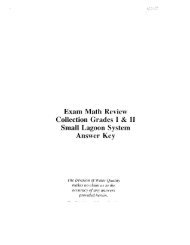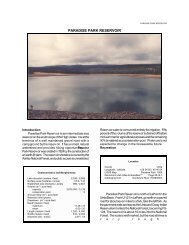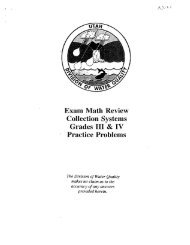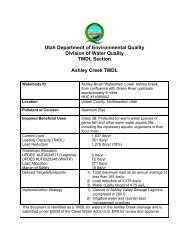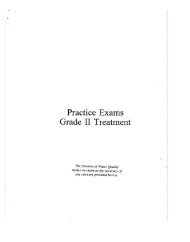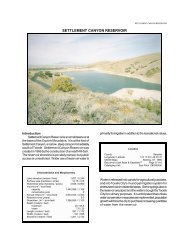DEER CREEK RESERVOIR - Division of Water Quality
DEER CREEK RESERVOIR - Division of Water Quality
DEER CREEK RESERVOIR - Division of Water Quality
You also want an ePaper? Increase the reach of your titles
YUMPU automatically turns print PDFs into web optimized ePapers that Google loves.
LAKE REPORTS<br />
D o C pH DO<br />
Cond<br />
0 18.5 8.1 8.2 393<br />
1 18.5 8.1 8.1 393<br />
2 18.5 8.1 8.0 394<br />
4 18.5 8.1 8.0 394<br />
5 18.4 8.1 7.9 394<br />
6 18.4 8.1 7.8 394<br />
8 18.3 8.1 7.8 394<br />
10 18.3 8.1 7.8 394<br />
11 17.7 7.8 5.8 394<br />
12 17.4 7.6 5.1 394<br />
13 17.0 7.5 4.8 395<br />
14 16.2 7.4 4.1 393<br />
15 16.0 7.4 3.9 391<br />
16 15.3 7.3 3.7 392<br />
17 15.0 7.3 3.5 392<br />
18 14.1 7.2 3.3 394<br />
20 13.3 7.2 3.1 402<br />
22 12.5 7.2 2.6 405<br />
24 11.5 7.1 1.7 416<br />
26 11.2 7.1 1.3 417<br />
28 11.1 7.1 1.2 418<br />
30 10.9 7.1 0.8 417<br />
32 10.8 7.1 0.6 422<br />
34 10.8 7.1 0.5 422<br />
35 10.7 7.0 0.5 420<br />
Temp<br />
conditions are<br />
deleterious to not<br />
only to the fishery by rendering some <strong>of</strong> the water column<br />
unsuitable for a fishery, but water downstream from the reservoir<br />
unsuitable for a cold water fishery until the dissolved<br />
oxygen concentrations increase to a point when they can<br />
sustain a fishery. According to DWR no fish kills have<br />
been reported in recent years. The reservoir supports<br />
populations <strong>of</strong> rainbow trout (Oncorhynchus mykiss),<br />
cutthroat trout (Oncorhynchus clarki), largemouth bass<br />
(Micropterus salmoides), smallmouth bass<br />
(Micropterus dolomieui), yellow perch (Perca<br />
flavescens), brown trout (Salmo trutta), carp<br />
(Cyprinus carpio) and chubs (Gila atratia). Walleye<br />
(Stizostedion vitreum) and crayfish have been illegally<br />
introduced into the reservoir. DWR typically stocks the<br />
reservoir with fry, fingerling or subcatchable rainbow and<br />
cutthroat trout and smallmouth bass.<br />
Macrophytes are not typically present and are not a<br />
problem. Traditionally, the DWR has stocked 100,000<br />
fingerling Smallmouth Bass in the spring and nearly<br />
100,000 subcatchable Rainbow Trout in both the spring<br />
and the fall. By the early 1990's, the Walleye population<br />
(illegally introduced) had become so dominant in the<br />
reservoir that<br />
it wiped out most <strong>of</strong> the trout fishery. In 1992, the DWR<br />
ceased to stock trout, and now stocks only the 100,000<br />
Smallmouth Bass. Fish populations are very dynamic<br />
from year to year, with Walleye being the predominant<br />
predator in the early 1990's.<br />
The reservoir has not been chemically treated by the<br />
DWR to eliminate rough fish competition, so populations<br />
<strong>of</strong> native Provo River fish may be present. Intensive<br />
stocking and angling for over 50 years have probably<br />
DO<br />
driven native fish populations to very small numbers.<br />
Phytoplankton in the euphotic zone include the<br />
following taxa (in order <strong>of</strong> dominance)<br />
Species<br />
Cell Volume% Density<br />
(mm 3 /liter) By Volume<br />
Aphanizomenon flos-aquae 12.888<br />
68.84<br />
Stephanodiscus niagarae 3.914<br />
20.91<br />
Anabaena spiroides<br />
var. crassa 1.557 8.32<br />
Oocystis sp. .175 0.94<br />
Melosira granulata .109 0.58<br />
Asterionella formosa .069 0.37<br />
Pennate diatoms .004 0.02<br />
Ankistrodesmus falcatus .004 0.02<br />
Total 154.917<br />
Shannon-Weaver 0.89<br />
Species Evenness 0.43<br />
Species Richness 0.30<br />
This sampling <strong>of</strong> the phytoplankton is representative <strong>of</strong><br />
July 14, 1992 and is not typical <strong>of</strong> the decreasing trend for<br />
dominance by blue-green algae.<br />
According to Rushforth (1992) the algal plankton flora<br />
<strong>of</strong> Deer Creek Reservoir, Wasatch County, Utah was<br />
studied throughout the 1991 calendar year. Quantitative<br />
net plankton and total plankton samples were examined.<br />
A total <strong>of</strong> 45 taxa was identified in the plankton flora. In<br />
addition, the two common categories, centric diatoms and<br />
pennate diatoms, each contain many additional taxa.<br />
The most important plankters as determined by<br />
calculating Important Species Indices (Isis) from all Deer<br />
Creek Reservoir combined net and total plankton samples<br />
collected during 1991 were Fragilaria crotonensis,<br />
Aphanizomenon flos-aquae, Stephanodiscus<br />
niagarae, Sphaerocystis schroeteri, Melosira<br />
granulata, pennate diatoms, Pandorina morum and<br />
Ankistrodesmus falcatus. These taxa all had Isis<br />
greater that 1.0. These eight taxa comprised 92.7% <strong>of</strong> the<br />
phytoplankton flora (as determined by calculating sum<br />
importance value) <strong>of</strong> Deer Creek Reservoir for the 1991<br />
year. This measurement is an assessment <strong>of</strong> algal<br />
standing crop and distribution through the year as<br />
reflected in our samples.<br />
Algae with ISI's greater that 0.10 included centric<br />
diatoms, Microcystis aeruginosa, Staurastrum<br />
gracile, Anabaena spiroides var. crassa, Dinobryon<br />
divergens, Asterionella formosa, Ceratium hirundinella,<br />
Chlamydomonas species, and Pediastrum duplex.<br />
Bluegreen algae together comprised approximately<br />
17.2% <strong>of</strong> the flora when measured by summing ISI's. This




